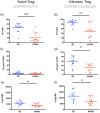FoxP3 isoforms and PD-1 expression by T regulatory cells in multiple sclerosis
- PMID: 29487369
- PMCID: PMC5829149
- DOI: 10.1038/s41598-018-21861-5
FoxP3 isoforms and PD-1 expression by T regulatory cells in multiple sclerosis
Abstract
Forkhead box P3 (FoxP3)+ regulatory T cells (Treg) are powerful mediators of immune regulation and immune homeostasis. In humans, Tregs are a heterogeneous population expressing surface markers which define phenotypically and functionally distinct subsets. Moreover, it is now clear that intracellular staining for FoxP3 does not unequivocally identify "true" suppressor cells, since several FoxP3 isoforms exist, and different reagents for FoxP3 detection are available. Here, we propose a strategy to identify potentially functional and suppressive Treg cells in an autoimmune disease like multiple sclerosis, and we suggest that in patients affected by this disease these cells are both reduced in number and functionally exhausted.
Conflict of interest statement
The authors declare no competing interests.
Figures





References
Publication types
MeSH terms
Substances
LinkOut - more resources
Full Text Sources
Other Literature Sources
Medical

